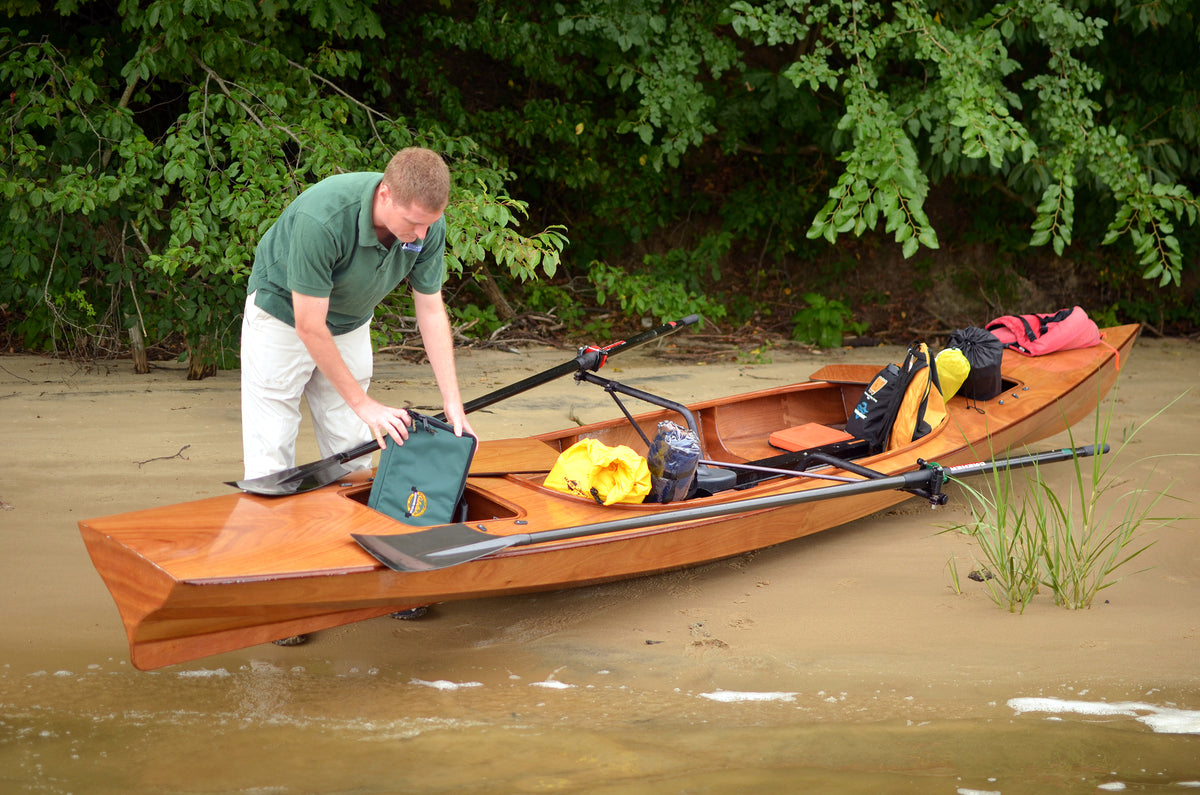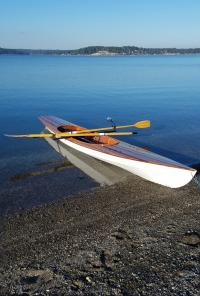Specifications
Performance
Stability
Speed
Cockpit Room
Payload
Ease of Construction

Overview
The Expedition Wherry is a fast, shapely craft intended for serious sliding-seat rowers who are looking for open-water ability and enough payload for camp-cruising. A "wherry" is a pulling boat that falls somewhere between the needle-thin racing shells and wider, sailboat-like, rowboats. Wherries are the ride of choice for rowers who want speed but don't want to confine themselves to the placid rivers that are the natural haunt of a racing shell.
The term "wherry" is English in origin, used as early as the 1500s to describe the swift water taxis in use on the River Thames. An 1878 book, Old and New London, remarks that in 1820 there were 3,000 wherries on the Thames. The basic wherry shape---a narrow waterline, that flares sharply above the waterlinr to gain stability as the boat heels or is loaded---has not been improved upon in centuries.
CLC's Expedition Wherry came about as a solution for fitness-oriented rowers who want to go out in cold or rough water, perhaps with camping gear. Designer John C. Harris, who has been designing, building, and enjoying sliding-seat boats for decades, spent a lot of time tinkering with the hull lines to find the best compromise between speed, payload, and stability. "As soon as you're not competing with the racing shells, the design of a rowing boat becomes much more multi-dimensional," Harris says. "Some of the characteristics that make a boat ideal for sprinting in flat water are completely at odds with performance in waves. I added a lot of rocker, which definitely gives the boat a nimble feel in waves, and as an added bonus keeps the wetted surface from creeping up on you."
Harris is especially proud of the bow shape. "I'm working within the limitations of a hull design that's really easy to build from a kit. But I think I got the distribution of volume in the forward third of the boat just right. It's quite fine down at the waterline, for speed, but with a pronounced 'shoulder' up near the deck to help the bow lift over waves. It's subtle but you can see that feature working in the video footage."
Most of the boat is decked in, with only a small "sump" area beneath the oarsman's heels to gather bilge water. An optional Elvstrom-type bailer can dispose of any water that gathers there. There are four separate watertight compartments, all accessible through hatches for gear storage. The boat has enough stability, and the compartments provide sufficient buoyancy, that it is possible to climb back into the cockpit after a capsize, bail it out, and continue on your way.
The official maximum payload is 423 lbs. Thus, a 200-pound oarsman could carry the equivalent of three infantry-sized backpacks worth of camping gear. (Of course, the lighter you pack, the faster the boat goes.) The standard flush deck hatches are large enough for tents, sleeping bags, and kitchen sinks of modest size.
While the boat is too short for tandem rowers, it CAN take a passenger. Just loosen two wingnuts, move the sliding seat forward about eight inches, and you have a setup that's perfect for a picnic row with your significant other, a rowing coach, your kids, a dog, or whatever.
As a single, the Expedition Wherry is fast. John Harris used the boat for four months during sea trials, accumulating GPS data while studying different stroke rates. "At a gentle cruising pace, about 50 percent pressure and 22-23 strokes per minute, you're doing 4.5 knots, or just over five miles per hour. The equivalent of an easy jogging pace on shore. Even with a couple of long breaks, you could cover 30 miles in a day, no problem." Pick up the pace, and you can sprint at 6.5 knots, Harris says. "The boat is topping out for me around 6.5 knots, or 7.5 mph, but I'm not much of an athlete compared to some rowers. A strong oarsman could keep that up for longer than I could!"
Comparisons to CLC's Annapolis Wherry design are inevitable, and warranted. The massively popular Annapolis Wherry has beguiled hundreds and hundreds of rowers over the years. Compared to the Expedition Wherry, the Annapolis Wherry is probably a little faster in smooth water. But with less freeboard and no deck, it has a much smaller payload (325 pounds) and is less suited to open water. "Everything's a compromise," says Harris. "If you're mostly rowing in protected water, and with light payloads, the Annapolis Wherry will prove faster. The Expedition Wherry is a bit more of a rugged backwoods boat, though, with loads of gear storage and the safety of the decking."
The Expedition Wherry is a multi-chined plywood boat, with a six-panel hull reinforced by six bulkheads. The hull is mostly 4mm okoume plywood, with fiberglass applied both inside and out. The computer-cut kit is intricately designed and highly evolved to suit fast and easy construction, including by first-time builders. Hull panels are snapped together with "puzzle joints," and all of the holes for the temporary wire stitches have been drilled in advance. Plans builders are provided with full-sized patterns for every part. An elaborate step-by-step instruction manual, with photos and drawings of every step, accompanies both kits and plans.

What builders are saying
Main Gallery
Construction Gallery
Line Drawings
Videos
Frequently Asked Questions
Take One of our Boatbuilding Classes
We offer classes for many of the boats we sell. Teaching sites stretch from Maryland to Washington State and from Maine to California. Click here to find out more.
View ClassesNeed Help Building it?
We’re here to help with any questions you might have during the build process.






































































